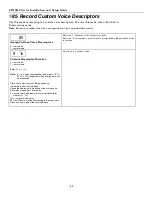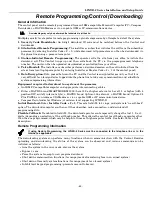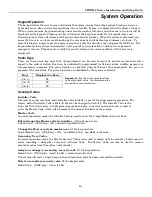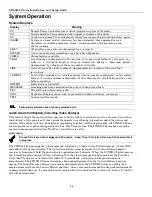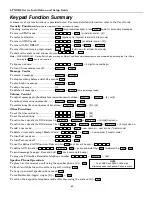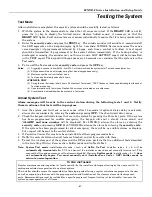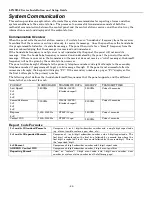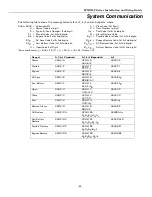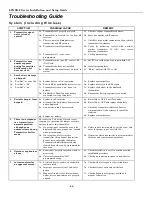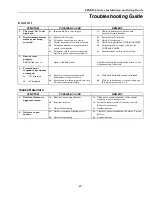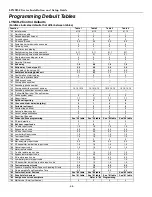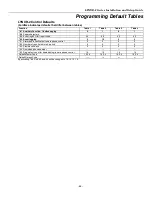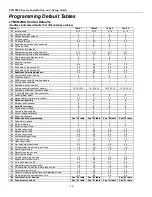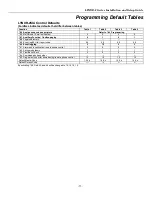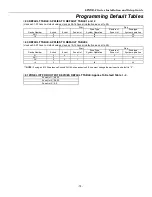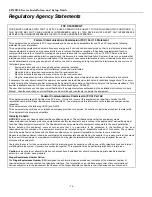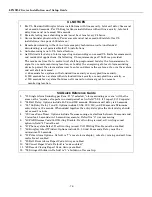
LYNXR-2 Series Installation and Setup Guide
- 66 -
Troubleshooting Guide
S y s t e m ( i n c l u d i n g W i r e l e s s )
SYMPTOM
POSSIBLE
CAUSE
REMEDY
1. Transmitter
signal
not received at
control.
1a. Transmitter not properly powered.
1b. Transmitter is located too far from RF
receiver.
1c. There is metal shielding between
transmitter and RF receiver.
1d. Transmitter
is
malfunctioning.
1e. Transmitter No. (zone) is not
programmed.
1a Check or change transmitter's battery.
1b. Move transmitter or RF receiver.
1c. Check for large metal obstructions, then relocate
transmitter if necessary.
1d. Verify by activating control with another,
similar transmitter. If O.K. now, return
defective transmitter.
1e. Verify
programming.
2. Transmitter
zone
number appears
during Transmitter
Sniffer mode, but
does not clear.
2a. Transmitter zone type (ZT) is set to 00
(Not Used).
2b. Transmitter battery not installed.
2c. 5800 System transmitter not "entered" in
system.
2a. Set ZT to a valid active zone type in field
✻
56.
2b. Install proper battery.
2c. "Enter" unit in field
✻
56 or
✻
83.
3. Low
battery
message
on keypad.
3a. "Low Bat" (no zone Nos.)
3b. "Low Bat" + "00".
3c. "Low Bat" + "nn".
3a. System battery is low or missing.
3b. Remote RF keypad/button battery is low.
3c. Transmitter for zone “nn” has a low
battery.
3d. Standard- or High-Capacity battery
connected to wrong receptacle.
3a. Replace system battery.
3b. Replace battery in the RF keypad.
3c. Replace the battery in the displayed
transmitter.
3d. Ensure that battery is properly connected.
4.
Periodic beep(s) from
keypad.
4a. System is in Test mode.
4b. A transmitter low battery has occurred
and is displayed.
4c. A supervision fault has occurred.
4d. System low battery
4a. Enter Code + OFF to exit Test mode.
4b. Enter Code + OFF and replace the battery.
4c. Check the transmitter indicated. Restore
communication to the receiver to cancel the
condition.
4d. Replace system battery
5.
There is no response
to a transmitter in
normal operation,
although zone
number clears during
Transmitter Sniffer
mode.
Put control in Test mode. If zone does not
respond, try operating the tamper switch or
another input to the transmitter.
5a. If another input causes the zone to be
displayed, the wrong input was "entered"
when programming.
5b. If no response at all from this
transmitter, this physical transmitter
has not been entered by the system.
Transmitter Sniffer display is being
cleared by another unit programmed for
this zone.
5a. Delete input's serial number (not the zone), and
enter the proper input (see field
✻
56).
5b. Determine which transmitter is programmed for
this zone and reprogram as necessary.
6.
Nuisance or phantom
alarm.
6a. Sensors not properly installed, wired, or
monitored.
6b. Universal transmitter (5817)
programmed wrong.
6a. Check installation to see if in accordance with
established procedure.
6b. Check programming switches on transmitter.
7.
Intrusion alarm for
no apparent reason.
7a. Protected door or window opened while
system armed.
7b. Improper user operation of exit/entry
delays.
7c. Magnets located too far from switches,
and/or doors and windows not properly
aligned.
7a. Check with all occupants of protected home.
7b. Check setting of entry and exit delays.
7c. Check all openings for proper switch and
magnet orientation.
Summary of Contents for LYNXR-2 Series Security System
Page 4: ... 4 ...
Page 78: ...LYNXR 2 Series Installation and Setup Guide 78 Notes ...
Page 79: ...LYNXR 2 Series Installation and Setup Guide 79 Notes ...
Page 80: ...LYNXR 2 Series Installation and Setup Guide 80 Notes ...
Page 81: ...LYNXR 2 Series Installation and Setup Guide 81 Notes ...
Page 82: ...LYNXR 2 Series Installation and Setup Guide 82 Notes ...

